
Here’s something I found out recently. The 20th Century Fox fanfare was originally composed by Alfred Newman back in 1933 and heralded the start of many movies before it was eventually phased out in the ‘70s. Then along came George Lucas, who decided that it would work rather well for his old-fashioned space opera, and reinstated it at the beginning of Star Wars. To complete the connection, John Williams composed the shimmering main theme of A New Hope in the same key so it felt like a continuation of the fanfare.
This explains a lot. One of my earliest screen memories is watching Star Wars with my parents when I was little and getting totally swept away by it from the first moment the Fox logo appears on screen, and I’ve been chasing the dragon ever since. To this day, hearing the fanfare gives me a serious case of Pavlovian Star Wars tingles.
In this sense, I probably have George Lucas as much as anyone else for my love of movies. I watched the original Star Wars trilogy over and over trying to recapture that same feeling, and when I got a bit older I found a natural successor in Raiders of the Lost Ark.
The first time I saw it, I was so thrilled and scared and delighted and there were times when I was so carried away that I could hardly breathe. I guess I was eight or nine at the time, and I must have watched it on VHS 50 to 100 times over that period. Then came a moment that has always stuck in my head. During the brilliant opening sequence, I noticed for the first time that parts of the temple are open at the top. I asked my mum, “Why doesn’t Indy just go in through the roof and avoid all the traps?” She simply said, “Maybe you’ve watched it too many times if you’re starting to pick holes.” Which was kind of prophetic, because 30 years later I started making a living from watching movies and picking holes in them.
Skip forward to Indiana Jones and the Kingdom of the Crystal Skull in 2008. We rarely went to the cinema all together as a family, but it seemed imperative that we all go to see the latest adventure in a series we’d enjoyed so much together while my sister and I were growing up.
It was the first Indiana Jones movie I’d seen on the big screen and it was a bittersweet experience. It was great sitting there all together for once, but our initial enjoyment faded to wistful disappointment by the end. By the time we left the theatre, we weren’t even that sad or angry about it. My sister and I both felt that Indiana Jones was best left as a fond childhood memory which we could revisit anytime through the original trilogy. And that was that; when I talk or think about the Indiana Jones movies, I genuinely need to remind myself that Crystal Skull even exists.
Another 15 years later and a fifth Indiana Jones film is upon us. I now have two kids of my own, aged 6 and 8, who both love the Indy movies too. Raiders of the Lost Ark was on my mental list of films I couldn’t wait to show them as soon as they were old enough, and it’s their pick of the bunch. I don’t hold too much hope for Indiana Jones and the Dial of Destiny, [Adam @ AotM - Oh ye of little faith Lee!] but I’ll still take them to see it at the cinema when it hits theatres this week. In my view, not letting them see it on the big screen would just be bad parenting.
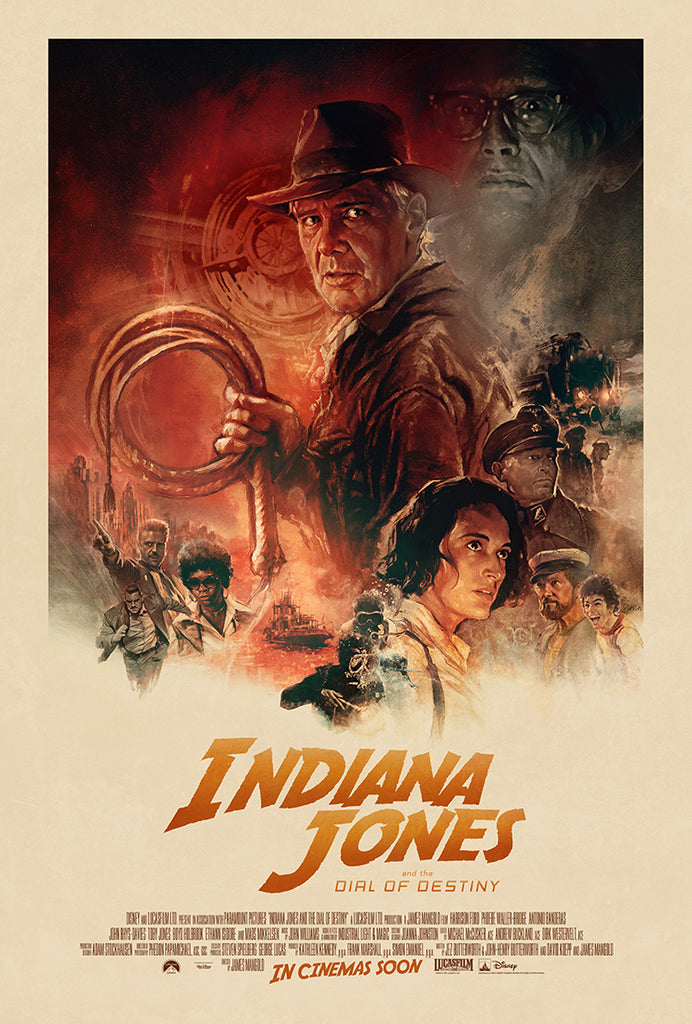
Tony Stella's movie poster for Indiana Jones and the Dial of Destiny
In anticipation of Harrison Ford’s latest (and hopefully last) outing as Indiana Jones, let’s take a look back at the first four movies in the franchise…
Raiders of the Lost Ark - “The Return of the Great Adventure.”
It is fitting that Indiana Jones inspires such nostalgia in millions of people because he was born out of nostalgia to begin with. George Lucas envisioned making a movie based on the old cliff-hanger serials he enjoyed so much as a kid after completing American Graffiti, tossing up between Doc Savage derring-do and a Flash Gordon-style space adventure.
He decided to go with science fiction first, resulting in Star Wars. It was almost certainly the right choice: While there were some doubts about whether A New Hope would be a success at the time, all concerns were quickly forgotten when it hit theatres. It stood out as something bright and shiny and new, not just in terms of the kind of sci-fi movies people were making then, but in relation to the entire fabric of American cinema in the ‘70s.
Although Steven Spielberg had set the template for the summer blockbuster a few years earlier with Jaws, it was very much the era of downbeat, character-driven, and often outright paranoid films of the American New Wave. Just to think, a year before Star Wars swept to global success, you still had movies like Taxi Driver, All the President’s Men, and Network. It was a call-back to a more innocent time that probably never existed and I’m not sure if a period-set action adventure, no matter how well made, would have become such a phenomenon at that time.
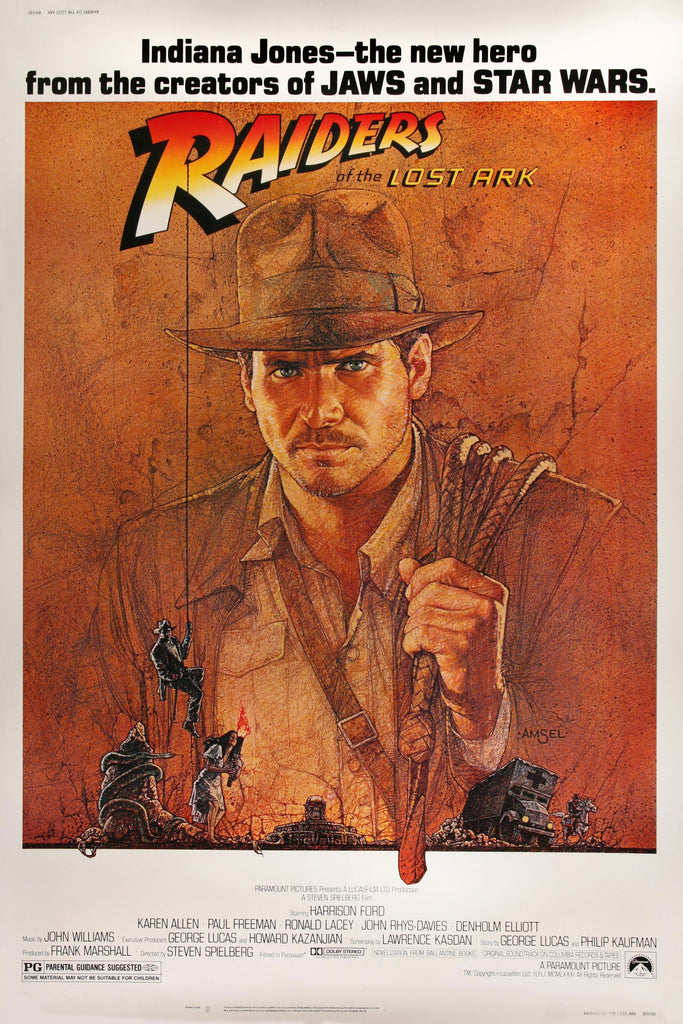
Richard Amsel's movie poster for the initial 1980 release of Raiders of the Lost Ark
Indiana Jones was conceived as a globe-trotting adventurer in the same vein as James Bond, but the ‘30s period setting was key to its charm and enduring timelessness. Over 40 years later, there is almost nothing that dates Raiders of the Lost Ark, apart from special effects that are very much of their era. A contemporary setting might have seen it age far worse - just take a look at For Your Eyes Only, the Roger Moore Bond movie released the same year, and see how dated that is by comparison.
Lucas’s adventure movie eventually ended up with Spielberg, who loved everything about the project apart from one small detail: The character’s name. At that stage, he was called Indiana Smith. That was a quick fix, becoming Indiana Jones, and off Lucas and Spielberg went in search of their intrepid archaeologist.
It is fairly common knowledge now that Tom Selleck was Lucas’s preferred choice, reluctant to cast Harrison Ford again because he didn’t want the actor turning into Bobby De Niro to his Martin Scorsese. Why he thought that would be a problem, I’ll never know, but screen test footage shows that Selleck probably would have been totally fine in the part. But Magnum P.I. beckoned and Ford got the job.
Ford brought a slightly murky and disreputable quality to Indy, whereas Selleck may well have played him more straight-up heroic. Ford also brought shade to his previous role as Han Solo in Star Wars, but two smaller parts really stick in my mind when considering what he gives to Indy’s character.
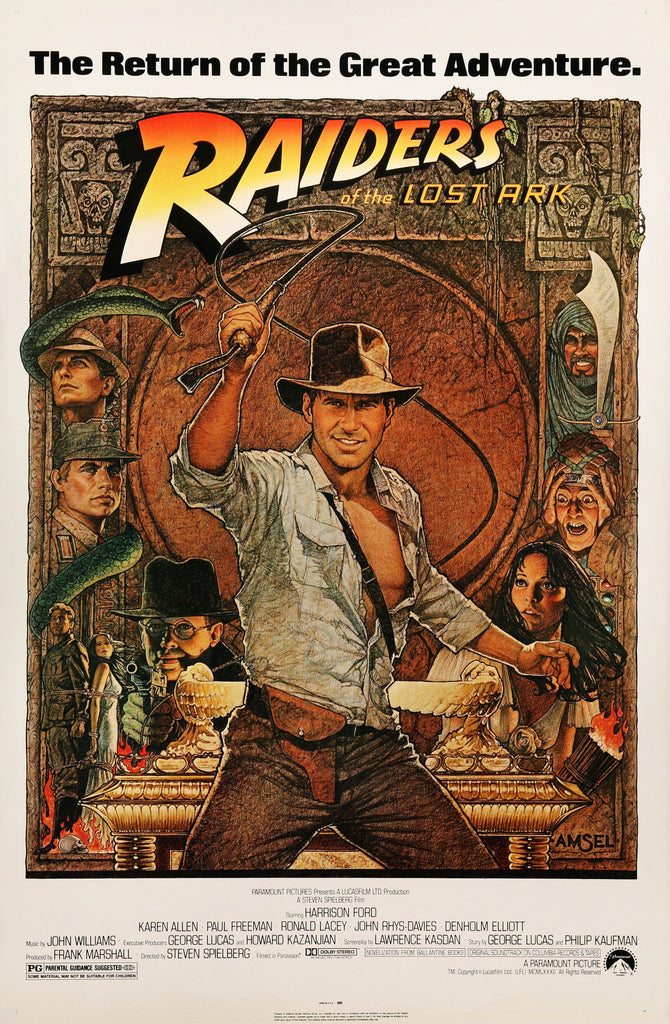
Richard Amsel's movie poster for the 1982 release of Raiders of the Lost Ark
In Francis Ford Coppola’s The Conversation, he plays a menacing young aide to a politician who intimidates Gene Hackman’s paranoid wire-tapper. Coppola cast him again in Apocalypse Now as a business-like military intelligence guy matter-of-factly telling Martin Sheen he must eliminate a fellow American. While he doesn’t overplay it, Ford also undercuts Indy’s loveable roguishness with an element of this sinister quality - the actor has said how he wanted to bring a little of Humphrey Bogart’s avaricious gold prospector in The Treasure of the Sierra Madre to the role.
It certainly shows: When I first saw the movie, I thought he was the bad guy when he first emerged from the shadows with a scowl on his face. There are other moments, too. It was Ford’s idea for Indy to ruthlessly gun down the Arab swordsman instead of a lengthy fight scene, and later, during the truck chase, he has a smile that suggests he actively enjoys killing Nazis goons.
The rest of the cast is great, too. Karen Allen is the perfect foil for Indiana Jones as Marion Ravenwood, not to mention deadlier: Marion racks up 12 kills to Indy’s 11 over the course of the movie and saves her former lover’s butt on a few occasions. Add to that Denholm Elliot, Paul Freeman, John Rhys-Jones, Alfred Molina, and Ronald Lacey in an unforgettable role as the slithery Nazi agent Toht, and you’ve got a cast of really great actors who help the supernatural-tinged plot really fly.
When it comes down to it, a movie like Raiders lives or dies on its action set pieces, and it begins with perhaps the greatest action sequence in all of American cinema. The opening temple run is a perfect mini-movie that introduces Indy’s character and establishes a typically Spielbergian atmosphere of mystery and wonderment that makes it very easy to suspend your disbelief for the rest of the film.
I can watch the scene over and over, and I think it is the perfect example of what an action set piece should do. We understand the characters and what they are trying to achieve; where they are in a three-dimensional space and which direction they are moving in; and, perhaps most importantly, the editing allows us to actually see what’s going on. It sounds simple but so many big movies fail to do this. Christopher Nolan, in particular, has taken plenty of flak for his jumbled action sequences.
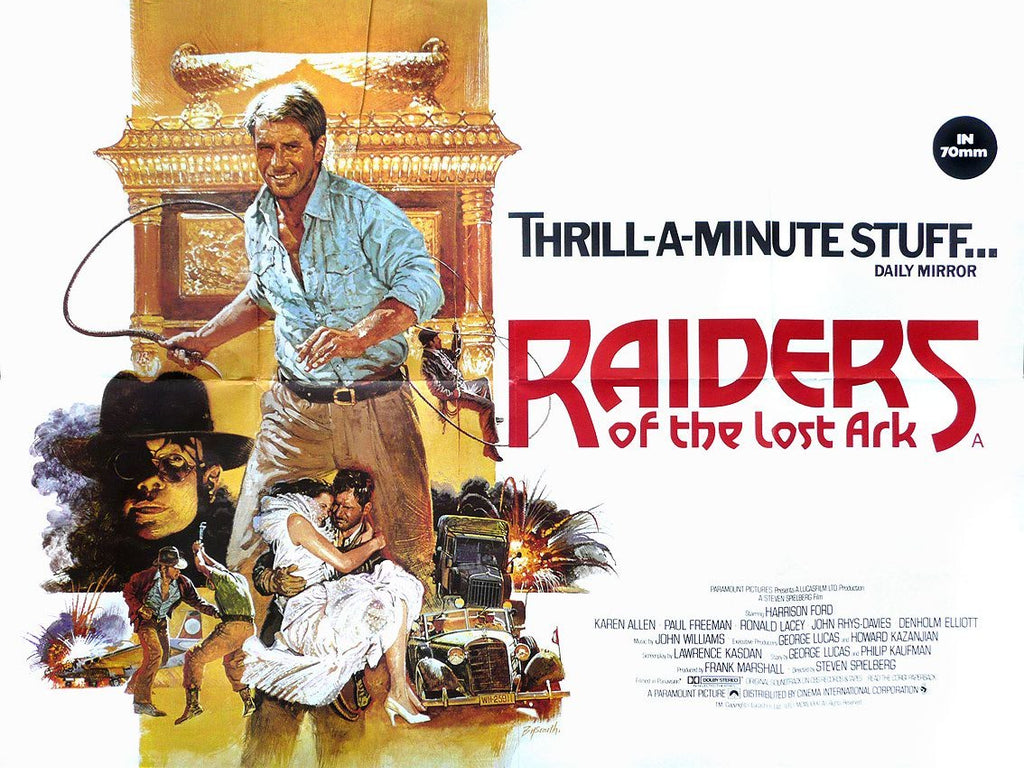
Brian Bysouth's UK Quad movie poster for Raiders of the Lost Ark
The control Spielberg has on the scene is a showcase for his dynamism and vision as a director. While there are reverse shots, Indy and his guide generally move left to right across the screen as they delve deeper into the temple, establishing the layout and pitfalls as they go. When the whole place comes crashing down around their ears, they go back in the opposite direction, adding new dangers and traps, not least a very large boulder. The scene was instantly iconic, and UK viewers were even treated to some great Terry’s Chocolate Orange adverts riffing on it.
Starting on such a high might spell trouble for lesser filmmakers, but Lucas and Spielberg were up to the task, aided by Lawrence Kasdan’s pithy screenplay. The rest of the action doesn’t let up, keeping the same breakneck pace throughout. However, if I’m being picky, it does feel like a bit of a let down to have Indy and Marion tied up and out of the game for the finale. But that hardly matters when spirits start swirling and heads start melting.
Raiders of the Lost Ark was a rip-roaring success at the box office and delighted audiences and critics alike. The love extended to awards season when it was nominated for eight Oscars, including Best Picture and Best Director. It took home four technical awards but lost out on the big prize to Chariots of Fire for Picture while Spielberg lost out to Warren Beatty for Reds, a film that no one has seen since 1981. The rousing score from John Williams lost out to the ethereal electronic work from Vangelis in Chariots. I guess we can let the Academy off on that one.
Indiana Jones and the Temple of Doom (1984) - “If adventure has a name… It must be Indiana Jones.”
Chilled monkey brains, anyone? Indiana Jones and the Temple of Doom is often maligned as the worst movie of the original Indy trilogy, and I can see why. Still, it’s a film that I enjoy a little more each time for many of the reasons that turned plenty of viewers and critics off: It’s darker, weirder, and more cruel than the swashbuckling Raiders. Certainly no one could accuse George Lucas and Steven Spielberg of simply trotting out a carbon copy, which many filmmakers might have been tempted to do after the smash success of their first film.
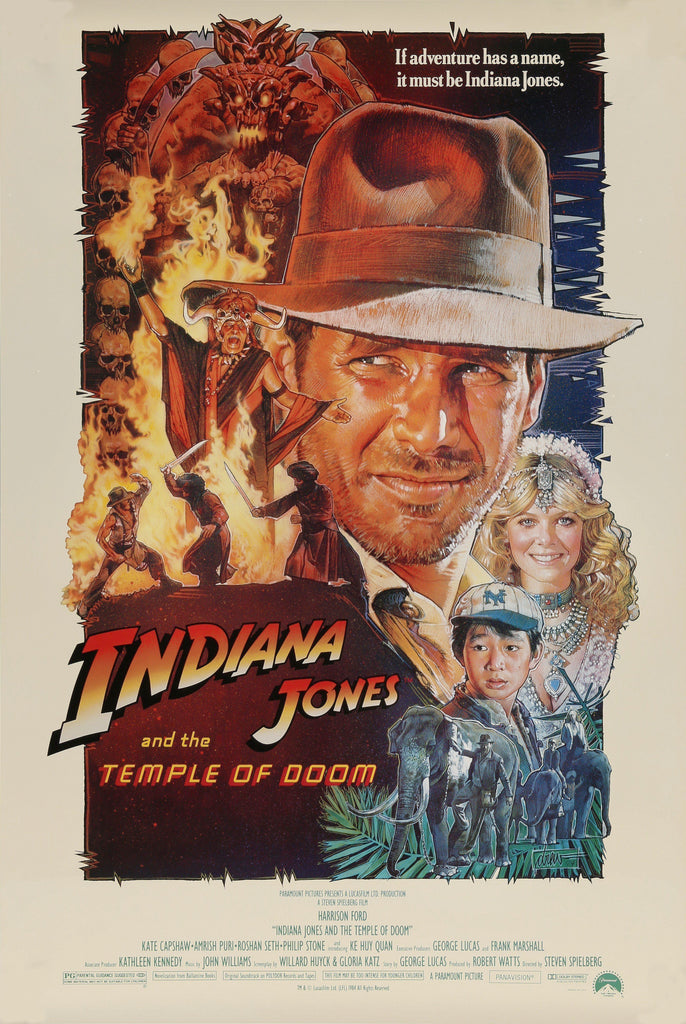
Drew Struzan's movie poster for Indiana Jones and the Temple of Doom
Lucas always intended Temple of Doom to be a darker middle instalment of the Indy trilogy, mirroring the sombre triumph of The Empire Strikes Back in the Star Wars saga. Yet even he has admitted that perhaps they went a little too far, attributing the bad vibes to the fact that he was going through a divorce at the time. Spielberg has also stated that it’s his least favourite of the first three movies, which is doing himself a disservice. For its flaws, Temple of Doom finds Spielberg with the same flair for action and comedy, albeit with a more ghoulish twist.
Let’s get to those flaws. Temple of Doom has long held a dubious reputation for Orientalism and crass cultural representation. These issues were present from the outset, when the production needed to relocate to Sri Lanka to circumvent concerns from the Indian government about the movie making their country look bad.
Meanwhile, a lot of blame is also laid at the door of Kate Capshaw’s Willie. With her preoccupation with clothes, nails, and makeup, she wasn’t the most progressive female character even at the time, and even Capshaw seems embarrassed by the amount of screaming in her performance. In her defence, while Willie does do an awful lot of shrieking, she’s also a completely different type of heroine from the ballsy Marion in the first film.
It’s a striking - if very irritating - contrast, but I will go to bat for her in some respects. She totally owns the big sequin-studded opening musical number (for which Capsaw learned the lyrics of “Anything Goes” in Mandarin), and her horrified reactions really sell the gross-out banquet scene.
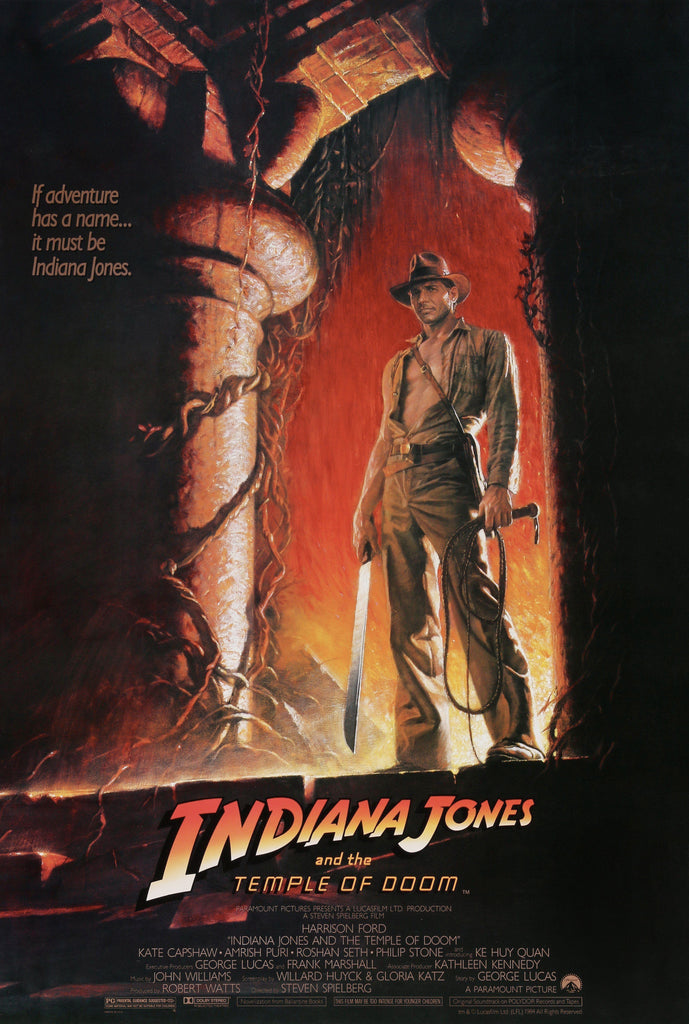
Bruce Wolfe's movie poster for Indiana Jones and the Temple of Doom
Another issue is that the Sankara stones MacGuffin and the Thuggee cult don’t capture the imagination in quite the same way as the Ark of the Covenant and the ever-reliable threat of the Nazis. That isn’t a major deal-breaker because they’re wrapped up in a horror-inflected story that pushed the boundaries for what was acceptable for family viewing at the time. A cult leader ripping the still-beating hearts from his victims before sending them to a fiery death was a bit strong for some tastes, and elements of child cruelty also left a bit of a sour taste. Along with Gremlins and Poltergeist (which Spielberg also had a hand in), Temple of Doom was instrumental in the MPAA’s decision to establish a bridging PG-13 certificate.
Temple of Doom’s flaws make it a fascinating contrast to the more wholesome original, which I guess is why I appreciate it so much. Harrison Ford seems more at home in the role this time around, getting himself in great shape for several shirtless moments, and exploring his dark side once again in disturbing scenes when Indy is turned into a voodoo servant of the cult leader. Ke Huy Quan makes up the central trio as Short Round in his screen debut, a precocious performance that is charming and/or irritating, depending on your preferences.
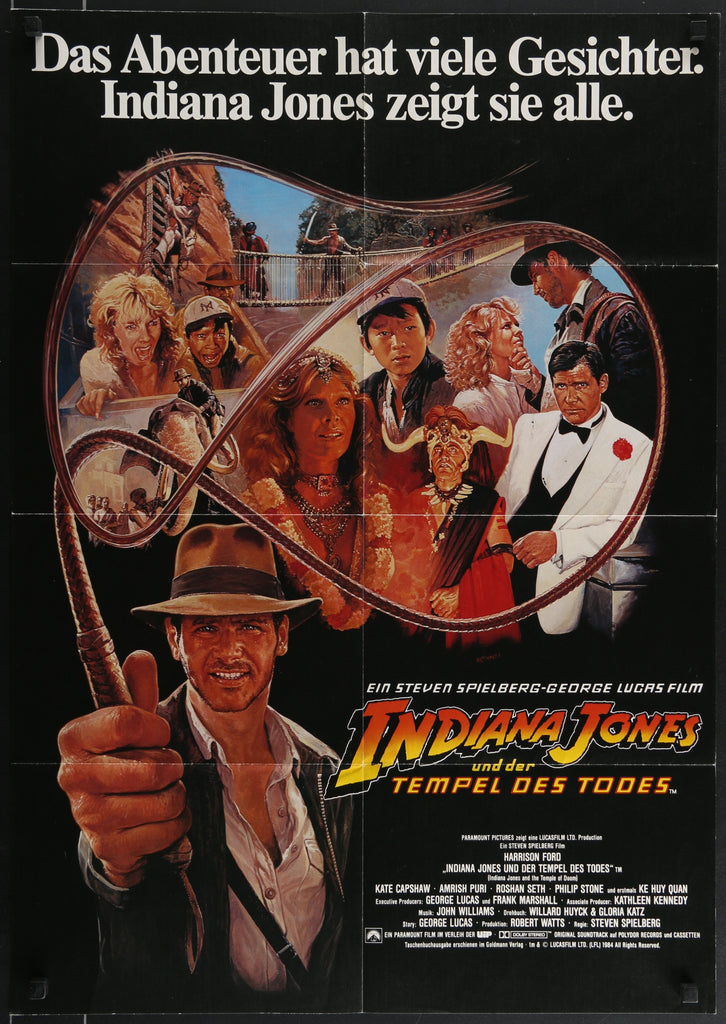
A German movie poster for Indiana Jones and the Temple of Doom. Artist unknown.
Improbably, Temple of Doom also rivals Raiders in terms of sheer excitement. Spielberg has cited the deadly spike room as his favourite scene in the movie, and Indy’s desperate battle to save Willie from a lava bath and his punch-up on a conveyor belt are just as nail-biting. If anything, the final confrontation on a rickety old rope bridge is even more satisfying than the wrath of God conclusion of Raiders because it also gives Indy something to do this time around.
Indiana Jones and the Temple of Doom was a major box office success, although, perhaps due to the negative publicity regarding the content, didn’t hit the heights of Raiders. Harrison Ford had signed on for three movies, so what could they do to correct the course of the series in the third one?
So there you have it, a brief summary of the first two Indiana Jones movies. We will pick up on the others next week.
Which movie is your favourite out of the series, and why? Let us know!




